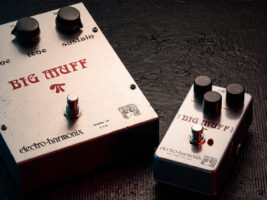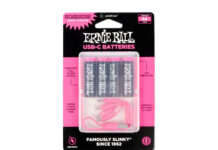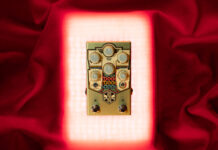
A guide to the best Big Muff-style pedals, from classic reissues to boutique oddities
The Electro-Harmonix Big Muff is one of those rare pedals that’s kept the collective imagination of guitarists engaged ever since its debut in 1969. Thanks to its frankly absurd sound (and, lest we forget – name) it remains one of the most recognisable and infamous distortion devices out there. Versions of it exist today as both official reissues, boutique recreations and greatly modified takes on the circuit from builders big and small. But which is right for you? Should you swing for a fancy boutique recreation or will one of the regular ol’ reissues have you covered? Let’s explore all things Big Muff.
Already au fait with the circuit, or just want to dive straight into some pedals? Click here to go straight to the best Big Muff-style pedals you can buy right now.
What makes a Big Muff circuit a Big Muff?
First things first – we’re going to be talking about a lot of the different parts of the base Big Muff’s actual circuit, so before we get completely lost in a haze of solder – let’s do a quick refresh as to how the Big Muff actually works.
While there are many different versions, most of the differences boil down to having different values into a consistent circuit. This is basically just effectively four gain stages stacked one after another, with a tone stack before the output. One gain stage sets the level of distortion. The second two boost and distort, and the final sets the output volume.
Most Big Muff-style pedals are based on a schematic of this general structure, with some additions and modifications to component values.
Input gain stage
This is a basic transistor-based amplifier that boosts and buffers the input signal, and removes some extraneous frequencies. It’s also where you’ll find the gain control, which works by controlling the level of signal going into the next part of the circuit.
Clipping stages
The next two transistors are used in (normally) identical configurations to distort the signal twice in a row. Two diodes are placed back-to-back in the feedback loop of each stage, creating soft clipping. But because of the extremity of the gain and the fact that it’s happening twice, the result is a hell of a lot of distortion, to the point where it’s as harsh and sharp-edged as any hard-clipping circuit.
The clipping diodes that are used here are a common modification for both DIY’ers and boutique variants. If you have a standard, large-box through-hole Big Muff, swapping the diodes out is a great way to experiment with modding! Try red LEDs for an open, less compressed sound – or Germanium diodes for a squishier, more compressed sound. Due to how the circuit works, though, it’s really only the second diode clipping stage that’s worth modifying – adjusting the first one won’t have much impact.
Some pedals also offer the option of removing one or both of the clipping stages entirely. This doesn’t remove all of the distortion, as there’s still some coming from overloading the transistors, but it does make for a much more boost-like sound and a big jump in output volume.
Tone stack
The classic Big Muff tone stack uses a potentiometer to create two different filters (one high-pass and one low-pass) and blend the result. Turning the tone control down mixes in more of the low-pass filter. Turn it up, the high-pass filter. In the middle, the two filters are combined – however on a stock Big Muff, both the high- and low-pass filters still affect the midrange when the knob is at 12, leading to that signature “scoop”.
The tone control’s use of a dual-filter design is also what allows it to be much more impactful than other passive tone stack designs – maybe too powerful, depending on the rest of your rig. A Big Muff on full treble can be a bit like having a jar of wasps chucked at your head, and on full-bass settings, it can easily overwhelm smaller amps. And while an overwhelmingly bassy distortion sound can be huge and awesome by itself, it can mean that you’re competing for sonic real estate with your bassist. Because of this, and the midrange scoop, the tone control is where you’ll see a lot of the ‘boutique’ Big Muffs make modifications.
Output stage
The Big Muff’s output stage is effectively an LPB-1 – this simply boosts the signal level back up after it gets cut down by the tone control’s filters. How much of a boost Big Muffs provide really varies – Muffs have used plenty of different transistors and component values across the years, meaning that some will give you a really hefty boost, while others will remain pretty close to unity gain. This is also something that ‘boutique’ big muffs can offer a little more control over.
The best Big Muffs you can buy right now
There are plenty of awesome options for fans of this venerable circuit still on the market. We’ve rounded up everything from the reliable classics to our favourite boutique oddities – so let’s jump in!
Electro-Harmonix Big Muff Pi
[products ids=”3yWcvIzNoO9xB6rijxsM35,7IfkFSlDLkpEAbSMV4CVg0″]
Electro-Harmonix still makes the standard, big-box Big Muff Pi. While it’s affordable and reliable, it’s also a rather inconvenient size – this thing really earns the Big part of its name. It has a certain cool factor, for sure, but if you want it in a more sensibly-sized box, you can check out the standard Nano Big Muff Pi. Keep in mind, though, that this modern variant of the circuit is famously a little more bright and scooped in the midrange than the more vintage-voiced circuits. This style of Muff was used to great effect by Jack White in the White Stripes with a scything, sharp sound.
Triangle Big Muff Reissue
[products ids=”33w8LgfNxoN927DUOTHnPB”]
This pedal is a recreation of the earliest version of the Big Muff. Compared to the more modern circuits, it has a smoother, slightly less saturated sound at max settings, but it can absolutely still provide that huge violin-like sustain the pedal is known for as a whole. Given the age of the circuit it’s recreating and how pedals were made at the time, there’s not really one single Triangle circuit this pedal is based on, however it’s a faithful amalgam of various vintage units.
Ram’s Head Big Muff Reissue
[products ids=”3rbb8zWI1Am5b80I7DisMT”]
The Rams head recreates the 1970s v2 version of the circuit. It’s relatively similar, sonically, to the Triangle Muff, if a little louder in its output. If you’re gunning for a Gilmouresque lead sound, you can’t go wrong with either this or the Triangle. There’s also the J Mascis version of the pedal, a nod to the Dinosaur Jr. frontman’s affinity for the circuit, however keep in mind that this is only a cosmetic change over the regular reissue.
Green Russian Big Muff Reissue
[products ids=”766c6czBla78kcYvjzRaYO”]
The Green Russian Big Muff recreates the version of the circuit made in EHX’s Russian Sovtek factory across the 1990s. It has a reputation as a bassy, more doom-appropriate version of the circuit with a bit more of a mid-push – and the reissue totally nails that sound. It’s a great pairing with an Orange amp, C-standard tuning and half a crate of beer.
Op Amp Big Muff Reissue
[products ids=”4JglNeTKWHiLWNcQRvCVRA”]
The Op-Amp version of the circuit replaces the four transistors with two op-amps. The result is quite a different sound, one that you’ll immediately recognise if you’re a Smashing Pumpkins fan. This is also notably one of the Big Muff reissues with a tone bypass switch – this makes the circuit skip the dual-filter tone control, resulting in a more full-frequency, less scooped sound.
Evil Eye FX Warg
[products ids=”5Adblgiy8zKnX1V6oCJEyG”]
Onto some non-EHX options! The Evil Eye FX Warg is one of the coolest new boutique Big Muff-inspired pedals I’ve checked out recently. Inspired by the Ace Tone FM-3, this pedal also offers a switch to go between the stock tone control values and a flatter midrange – perfect for getting your full-bore fuzz sound to fit better in a mix.
Check out my review of the Warg for more.
EarthQuaker Chelsea
[products ids=”6VBp7ssc3rNh5JahzXOYDy”]
The first of three high-quality options from EarthQuaker Devices, the Chelsea is a cool variant of the Big Muff based on a unit owned and used by LCD Soundsystem’s James Murphy. It’s voiced really well for both bass and low-tuned guitars, and includes a tone bypass switch for some extra versatility.
Check out my review of the Chelsea for more.
EarthQuaker Hizumitas
[products ids=”yAw13mlAO4DY6NhkuqTZL”]
Where the Chelsea is relatively restrained, the Hizumitas is less so. It’s one of the loudest Big Muff variants out there, which is unsurprising if you’ve ever heard Boris’ music. Wata’s Elk Sustainar unit – a rare Japanese clone of the Big Muff – was meticulously recreated here, and its enormous output and unique tone sweep allow you to tune down and drop out with the best of them.
EarthQuaker Hoof
[products ids=”1InHpMjPOVeUbz2pEtcVVa”]
Rather than any one musician’s pedal, the third EQD option here is a very modified version of the EHX Green Russian. It uses a mix of germanium and silicon transistors for a more ragged, unpredictable sound, as well as some LED clipping diodes rather than the standard 1N4148s you’ll see more commonly used. If you’re looking for something totally original, rather than just a vintage recreation, this is a great option.
Black Arts Toneworks Pharaoh
One of the oldest doomed-up takes on the circuit, first launched back in 2011. The Pharaoh adds a separate highs control for more detailed EQ, as well as a three-position switch to choose between germanium, silicon or no diode clipping. That last option helps it sit well in a full rig based around pushing the front end of a tube amp for a thick, full-bore sound.
Keeley Electronics Moon
The Keeley Electronics Moon is an expanded version of the Op Amp Big Muff, featuring a three-position EQ switch for either scooped, flat or boosted midrange. It’s a pretty bassy version of the circuit overall, despite this added versatility – so make sure your rig is ready to handle the extra low-end! If it can, though, this is an awesome way to get that full-frequency Smashing Pumpkins-esque sound, or create a huge base-layer for shoegazey reverb. It’s also a killer option for bass guitarists.
KMA Machines Chief Disruptor
[products ids=”4oLU8h4shIbKDKspad4gzO”]
Now we’re into the real weeds of totally weirding the standard Muff circuit. The KMA Machines Chief Disruptor features a bunch of added features, including three different gain modes, a pre- or post-EQ clean blend, an active two-band EQ, a foot-switchable, expression-controllable parametric midrange and a switchable top-boost. If the Chief Disruptor can’t find a place in your rig, perhaps nothing can.
Death By Audio Fuzz War
[products ids=”5aAOX4JGOqtMcIFmIdHnFA”]
The Death by Audio Fuzz War is an example of just how far you can take the circuit, but not necessarily by adding extra features. Version two of the Fuzz War shares some similarities with the Big Muff in the rough circuit topology, but the resulting sonics are totally out there – it’s extremely loud and very dynamic thanks to a single clipping stage. The Fuzz War is great for those looking to go all psychedelic freak-out mode as much as it is for those looking to summon monoliths of doom and destruction.
Other options
There’s no way we could ever cover all of the Big Muff-inspired pedals out there – it is, after all, one of the most revered, cloned and modified circuits within the world of pedals. There are countless small builders doing everything from heavily-adjusted versions to faithful vintage recreations!
The post A guide to the best Big Muff-style pedals, from classic reissues to boutique oddities appeared first on Guitar.com | All Things Guitar.
Source: www.guitar-bass.net












